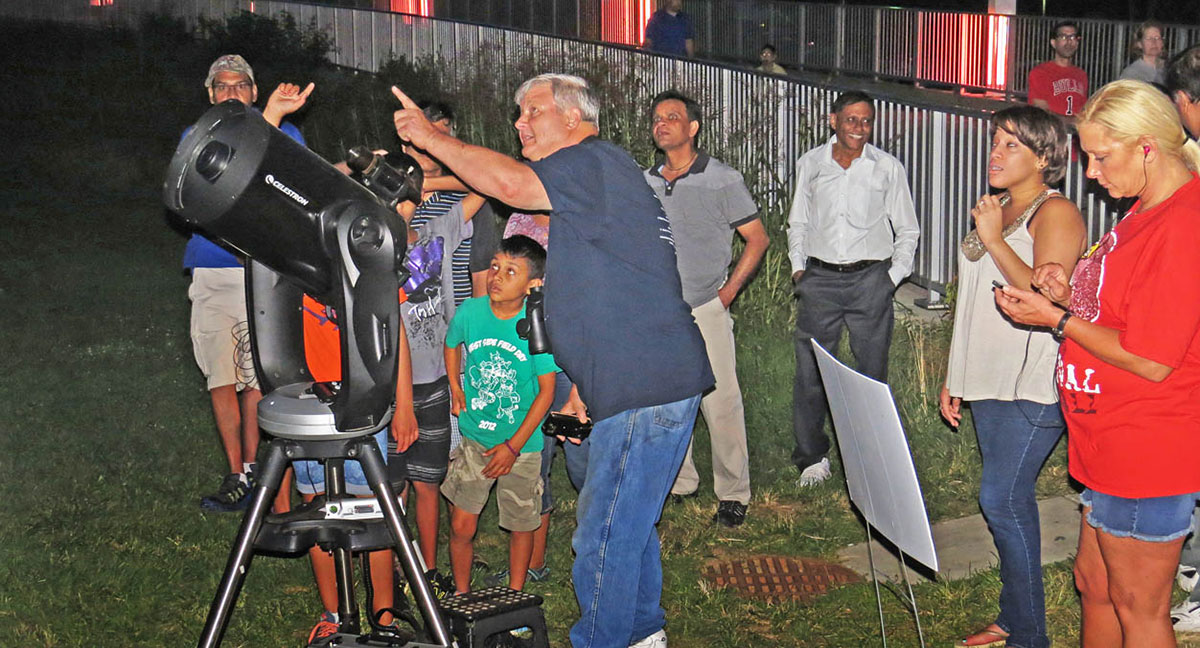Throughout the existence of humanity, people have been fascinated by the night sky. Making sense of seasonal shifting stars and tracking constellations has always had a place in culture and folklore. Since it began in 1933, the Louisville Astronomical Society (LAS) has cultivated interest in and educated the public about celestial objects, their properties and movement. It is dedicated to outreach programs for schools, colleges, libraries, churches, science fairs, state parks and scout groups. Besides conducting events and talks in the community, the LAS has two main educational sites. Both the James G. Baker Center for Astronomy in Curby, Indiana, and the Urban Astronomy Center (UAC) at E.P. “Tom” Sawyer State Park in Louisville, Kentucky, are maintained by members.
There are several different reasons why the society’s more than 250 members joined, but each enjoys the thrill of stargazing. Typical participants are anyone interested in the night sky. They might be construction workers, lawyers, accountants or computer scientists. Some are educators or astrophotographers. There are several families who enjoy viewing the night sky as an activity they can do together.
The current president, Steve Katsikas, became interested in astronomy when his sons were Boy Scouts. While chaperoning a camping trip, he was impressed by a presentation given by the LAS. Several years later, he joined in 2020.
“The programs we give are tailored to the age of the participants. We see an interest in space sprouting in very young kids. Kindergarten, first grade or second are not too young. We make it fun by conducting activities such as ‘Name That Nebula.’ But there is nothing like showing Saturn through a telescope to someone that has never seen it before. I’ve seen tears come into their eyes,” Katsikas says.

Chuck Allen, president of the Astronomical League, a national umbrella organization for amateur astronomy societies of which LAS is a charter member, agrees. In 1991, while LAS president, he and Scott Conner, who was secretary of the Evansville Astronomical Society, founded Stars at the Beach. Every summer, this public observation event is held at Patoka Lake in the Newton-Steward State Recreation Area.
“It’s great to have a scope up and help people see something for the first time. I remember once I was working with some scouts for a merit badge. We met three nights a week for a couple weeks. Some kids got so interested they wanted to stay all night long,” Allen says.
A dark sky, one that is free from light pollution, is needed to view the planets, stars and constellations. These optimal conditions are shrinking and necessitate driving to locations outside of cities. From 1955 to 1972, Star Lane Observatory was the center of LAS programming and educational outreach. Unfortunately, it was closed due to excessive amounts of artificial light surrounding it.
“I’ve been interested in astronomy ever since I was little,” says Karl Schmidt, who has served the organization as vice president, secretary and historian. “In the ’70s and ’80s there was plenty of black sky. Now there is a lot of light pollution, and the skies are washed out. Today kids must travel outside of their community to see stars.”
For several years after the closing of Star Lane Observatory, LAS looked for a site for another observatory. In 2000, the organization purchased 40 acres in Curby, Indiana, which was the darkest spot members could find within an hour from downtown Louisville. The goal to establish a well-equipped observatory from which supernovas, galaxies and nebulas could be seen became a reality when the LAS James G. Baker Center for Astronomy Observatory was completed in 2004.
Members refer to the observatory as “Curby,” a nod to its location. The roof slides off, allowing the telescopes to aim up at the stars. The property has several acres of camping space and a building with restrooms, a classroom and kitchen. Once a month, the observatory hosts an event for nonmembers. Members meet there each month during the time surrounding the phase of a new moon.
The UAC opened its doors in 2007. It is located at E.P. “Tom” Sawyer State Park. This education center includes a classroom, computer lab, kitchen, four acres of observing field plus a restroom. It, along with the Curby location, is the site for Star Camp. This weekend experience of stargazing and instruction includes the opportunity to meet the requirements for scout merit badges but can be customized for different groups.
LAS saw a huge increase in interest during COVID. Viewing the sky was something people felt they could do safely. However, both before and after the pandemic, there has always been interest in the public events the society has sponsored. Over its more than 90 years of existence, thousands have participated in the organization’s outreach programs. In 1993, a record for public astronomic observations was set when more than 3,000 people attended a meteor sighting event in Long Run Park.
Katsikas shares that most of the organization’s funding comes from membership dues and donations. It is a 501(c)(3) nonprofit organization, and its programs are purely volunteer run; it has no paid staff. Members may have periods when they devote a lot of their time to LAS but then become less involved as other personal commitments become more pressing, only to jump in again a few years later.
“People just need binoculars to get started; they don’t need to invest a lot of money. We do have an educational talk regarding choosing and using a telescope for beginners. The LAS partners with the Louisville Free Public Library to provide a telescope lending program for the Louisville area, including some libraries in southern Indiana. The sky is there for everyone. A lot of people don’t take the time to look up,” Schmidt says.
“If you are a member, LAS has 12 different types of telescopes that can be checked out. It’s good for those who want to try one out before they buy. To join, you don’t need a special background—just an interest. There is lots of support, no matter what level, and there’s nothing better than being mentored. We have lots of activities and plenty of good people. Members have access to an incredible wealth of knowledge, and $50 a year is a great bargain,” Katsikas says.
Information about upcoming LAS events, membership and donating can be found on the organization’s website, louisville-astro.org. It maintains a group Facebook page which shares information about current sighting opportunities plus awe-inspiring photos. The public’s questions can be answered by emailing louisvilleastro@gmail.com.





